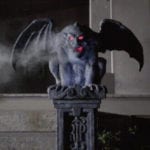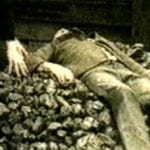10 The Spontaneous Combustion Of Matilda Rooney
A farmhand named John Larson spent Christmas 1885 with his employers, Patrick and Matilda Rooney, an elderly couple who lived just outside of Seneca, Illinois. They shared several drinks before Larson retired for the evening and went upstairs to bed. Sometime during the night, he underwent a coughing fit and had trouble breathing, but soon drifted back to sleep. When Larson woke up on Christmas morning, traces of soot were on his pillow. Larson went downstairs and was shocked to find Patrick dead in his bedroom. Matilda was nowhere to be found. Later that day, Larson wandered into the kitchen and found a large blackened hole in the floor. It rested alongside what appeared to be the charred remains of a human foot. A pile of ash was inside the hole. This was all that was left of Matilda Rooney. It seemed that Matilda was the victim of spontaneous human combustion, which caused her entire body to catch fire and burn to ashes. The estimated temperature of the fire that consumed her was 1,400 degrees Celsius (2,500 °F), but there were no other signs of fire damage other than that spot. It was later determined that Patrick had died of smoke inhalation. This explained Larson’s coughing fit during the night. He was spared from death because he slept behind a closed door on the second floor. Even though there was speculation that Larson could have murdered Matilda, it seemed impossible for him to have started such a blazing fire without damaging the rest of the house. It’s possible that excessive alcohol consumption caused Matilda Rooney to spontaneously combust. A prominent local legend was that she suffered divine retribution for daring to drink so much on Christmas Eve.
9 The Hit-And-Run Of Kevin Showalter
On Christmas Eve 1973, 20-year-old college student Kevin Showalter and his girlfriend were driving through New London, Connecticut when their vehicle got a flat tire. Kevin pulled over and was in the midst of changing the tire when he was struck by a passing vehicle and killed. Kevin’s mother soon sensed that something was wrong when she went to retrieve her son’s personal effects from the scene but was told they had been lost and that his death would probably never be solved. Her subsequent investigation would uncover allegations of shoddy police work and a potential cover-up. Harvey Mallove, a former mayor of New London, was considered a potential suspect because he had driven through the area at the time of Kevin’s death, but provided testimony which contradicted eyewitness accounts of the accident. A one-man grand jury determined that Mallove was the most likely culprit, but there was not enough evidence to file criminal charges. Mallove maintained his innocence, and in 1979 a man named Paul Hansen came forward to confess that he was the hit-and-run culprit. By that point, the statute of limitations had expired, so no charges could be filed against Hansen. Another grand jury was convened, but they determined that there was no evidence to support Hansen’s claim, so the inquiry was closed. The case remained cold until 2005 when Hansen committed suicide. He left behind a note once again claiming responsibility for Kevin’s death. Police decided to reopen the case, but when the local media requested transcripts from the earlier investigations, they were denied. In fact, the 3,000-page transcript from the original grand jury investigation on Mallove had mysteriously gone missing. To this day, Kevin Showalter’s death is still officially unsolved.
8 The Pleasant Valley Memorial Park Jane Doe
It’s a very sad occurrence when a person is found dead and no one knows their true identity. If the victim cannot be identified, he’s called John (or Jane) Doe. This situation occurs many times per year, but in 1996, one particular Jane Doe made a concerted effort to ensure her identity remained a mystery. On December 18, a woman was found lying dead atop a plastic sheet in Annandale, Virginia at the Pleasant Valley Memorial Park cemetery. She was approximately 60 years old and carried no identification. Brandy and Valium were found in her system. A plastic bag was taped over her head. She had asphyxiated. It seemed she did not want anyone to know her identity as she had a note which read, “Deceased by own hand… prefer no autopsy.” It was signed “Jane Doe.” Jane Doe also requested to be cremated and left behind two $50 bills to cover the expense. The scene contained many strange clues about this mysterious woman’s background. She had set up a miniature Christmas tree beside her and decorated it. She also had a portable tape player and comedy tapes in her possession. She died with headphones on, listening to the famous “2000-Year-Old Man” comedy routine by Mel Brooks and Carl Reiner. The most intriguing aspect of Jane Doe’s suicide was that she was found in the section of the cemetery where deceased infants were buried. Sadly, no one has ever come forward to identify Jane Doe, and her motivation remains a mystery.
7 The Murder Of Rhonda Hinson
Nineteen-year-old Rhonda Hinson worked a clerical job at a steel company in Hickory, North Carolina. On the evening of December 22, 1981, Rhonda attended a company Christmas party and left with two of her friends. After dropping them off, Rhonda headed for her home in Valdese and wasn’t far away when she became the victim of a bizarre homicide. A high-powered rifle was used to fire a shot at Rhonda’s vehicle from an unknown location. The bullet managed to travel through the trunk and the driver’s seat before striking Rhonda in the heart. Her vehicle was found by the side of the road with the driver’s door open. Rhonda’s body was lying several paces away. The circumstances of how or why she was murdered remain unclear. Rhonda had been acting strangely toward her parents in the preceding weeks. She dropped hints that she was concealing a terrible secret and made an unusual inquiry to her mother about the appropriateness of dating a married man. On the night of the murder, a motorist drove past Rhonda’s car and saw an unidentified man standing next to the driver’s side door with Rhonda slumped over the steering wheel. The witness did not know that Rhonda was dead at the time, but he did see a Trans-Am parked down the road a short distance away, which may have belonged to the man seen next to Rhonda’s vehicle. If this man fired the fatal rifle shot from a distance, why did he approach her car and drag Rhonda’s body out onto the road? Was her death an accident or cold-blooded murder? These questions remain unanswered.
6 The Disappearance Of Patty Vaughan
On Christmas Day, 1996, 32-year-old Patty Vaughan left her home in La Vernia, Texas and never returned. Her van was found 25 kilometers (15 mi) away the following day. One of the tires was flat, and there were traces of blood in the van as well as a red workman’s jumpsuit. Right before her disappearance, Patty had allegedly gotten into an argument with her estranged husband, J.R. That was the last confirmed sighting of her. The couple had three children but had separated two months earlier. J.R. was jealous that Patty was dating another man and raised eyebrows when he filed for divorce the day after she went missing. Traces of blood were found in Patty’s bedroom and on a mop inside her residence, indicating that someone had been cleaning the place. It was also apparent that the carpet in Patty’s van had recently been shampooed. DNA tests confirmed that all the bloodstains belonged to Patty. The case took a bizarre turn two months later when Patty’s mother burst into J.R.’s home and attacked him with a baseball bat. Nevertheless, there was no evidence to implicate him in Patty’s disappearance, and he took custody of their children and left the state. However, during the time Patty went missing, J.R. was working construction on a school in the nearby town of Natalia. Authorities have not discounted the possibility that Patty’s remains might be encased in the concrete foundation and that multiple people were involved in the disposal of her body. Years later, DNA testing was performed on items found in Patty’s van. The DNA was determined to be female, but did not belong to Patty Vaughan, adding further intrigue to this unsolved case.
5 The Murder Of Tracy Mertens
In 1994, 31-year-old Tracy Mertens moved to Rochdale, England, with her boyfriend, Joey Kavanagh, and their two children. Two days before Christmas, Tracy decided to return to their former residence in Birmingham to pick up some belongings. While Tracy was there, there was a surprise knock on the door, and two black men came bursting inside. They proceeded to restrain Tracy before blindfolding and abducting her. The two assailants drove to the town of Eaton and left Tracy on the steps of a church. They doused her with gasoline and burned her alive. When Tracy was found, she had burns on 90 percent of her body but was still breathing. She was taken to a hospital and lived long enough to describe what happened to her before passing away on Christmas Eve. The most intriguing part of Tracy’s story was that her two unknown attackers reportedly asked, “Where’s Joey?” after bursting into the home. After Tracy told them her boyfriend wasn’t there, they decided to abduct her and leave the area. During their time together, Tracy and Joey often had a strained relationship. Joey had frequent issues with heroin addiction and owed people money at the time of Tracy’s death. Joey contended that these issues are unconnected to Tracy’s murder and claimed to have no idea who was responsible.
4 The Warminster ‘Thing’
One of the United Kingdom’s first UFO hot spots was a small town named Warminster. Throughout the 1960s and 70s, Warminster was a haven for UFO sightings. However, the sightings were not initially flying objects, but unexplained sounds. On Christmas morning in 1964, many Warminster residents were disturbed by a series of strange noises, which consisted of strong, pounding vibrations and could best be described as “sonic attacks.” One resident was awoken by the repeated sound of something falling onto her roof. When she looked out the window, she heard a strange humming noise, but the weather was clear and nothing had come into contact with the roof. This same experience was reported by many different residents in different locations that morning, including 30 soldiers at a nearby base camp. However, no one saw anything strange, nor could they figure out where these sounds originated. The most unusual incident involved a resident named Marjorie Bye. While walking to church for a Christmas service, Bye was so overwhelmed by vibrating noises that she was knocked to the ground and rendered unable to move. In her own words, she was “pinned down by the invisible fingers of sound.” Over the course of the next year, there were numerous reported incidents of strange unexplained sounds in Warminster. These noises were eventually nicknamed “The Thing.” By summer 1965, witnesses started reporting unidentified flying objects in the sky. Warminster garnered a ton of publicity after a photograph of a flying saucer was published in the newspapers. UFO enthusiasts starting flocking to the town, but the hype eventually died down and there would be no more visits from “The Thing.” Even so, no one has ever been able to explain the origin of the strange sounds heard on Christmas 1964.
3 The Disappearance Of Nikole Betterson
Jarrett Betterson and Susan Klingel lived in Dearborn, Michigan with their two-year-old daughter, Nikole. Tragically, in September of that year, the couple got into a car accident. Susan was killed. It wasn’t long before Jarrett became involved with a woman named Barbara. Around Christmastime, Jarrett and Barbara surprised Susan’s family by announcing they were moving out west with Nikole. The couple did not give the Klingels their exact destination and told conflicting stories to friends about where they were going. Jarrett and Barbara weren’t heard from again for 20 years, and Nikole was never seen again. Almost 20 years later, the Klingel family finally hired a private investigator to determine Nikole’s whereabouts. He tracked down Jarrett and Barbara, who were living in Las Vegas. Even though the couple had spent years collecting Nikole’s Social Security benefits for children with deceased parents, she was nowhere to be found. There was no paper trail for her after she left Michigan in 1977. The police soon got involved, and Jarrett promised to tell them the whole story about what happened to Nikole. However, he never got around to doing so. Shortly before Christmas, on the 20th anniversary of Nikole’s disappearance, Jarrett shot his wife to death and then turned the gun on himself. Before she died, Barbara mailed a letter to the Klingels apologizing for everything she had done, but did not provide any details about what happened to Nikole. If still alive, Nikole Betterson would be 39 years old today.
2 The Murder Of Latricia White
Thirty-eight-year-old Lockhart, Texas resident Latricia White was spending Christmas 1994 with her boyfriend, Lee “Dub” Wackerhagen, and his nine-year-old son, Chance. Chance was supposed to be returned to his mother on Christmas Day, but called her to request a few more days with his father. On December 27, after not hearing from his daughter for a while, Latricia’s father decided to visit her home. He was shocked to discover Latricia dead in her bed. She had been shot six times with a .22-caliber weapon. Dub and Chance Wackerhagen were nowhere to be found. Since Dub was known for having a violent temper and reportedly got into a heated argument with Latricia shortly before Christmas, he was the prime suspect in her murder. A warrant was issued for Dub Wackerhagen’s arrest. However, there is still debate about whether Dub took Chance and went on the run as a fugitive or if they were both victims themselves. Three days later, Dub’s pickup truck was found abandoned in a field 50 kilometers (30 mi) away. Many items were found inside, including Dub’s wallet and checkbook. The most compelling piece of evidence was a heap of unopened Christmas presents in the back, some of which were covered with blood. Surprisingly, the blood did not match Latricia White, lending credence to the possibility that Dub and Chance fell victim to an unknown party who subsequently disposed of their bodies. Months later, Chance’s maternal grandmother got an anonymous phone call from a young boy who said, “Help me.” The call was cut off, but she thought the boy might have been Chance. No one knows if Dub and Chance Wackerhagen were murdered that Christmas or if they’re still hiding out somewhere.
1 The Author Of ‘Twas The Night Before Christmas’
Virtually everyone who celebrates Christmas is familiar with the poem “A Visit from St. Nicholas,” aka “Twas the Night Before Christmas.” Believe it or not, the origin of this poem has some mystery attached to it. For many years, no one knew who wrote it. “A Visit from St. Nicholas” was sent anonymously to the Sentinel, a newspaper in Troy, New York, and first published on December 23, 1823. The poem proved enormously popular, but the author’s identity was unknown. Finally, in 1844, a professor named Clement Clarke Moore claimed credit for writing the poem, which had been sent to the Sentinel by one of Moore’s friends. The story goes that Moore was hesitant to take credit for the poem because he was embarrassed by it and considered it unscholarly. However, some historians do not believe Moore was the actual author. A professor named Donald Wayne Foster presented compelling evidence in 2000 that the real author of “A Visit from St. Nicholas” was actually Henry Livingston Jr., who died in 1828. Foster believed the poem bore a striking resemblance to Livingston’s other writings, but was a strange anomaly in Moore’s body of work. Some called Moore a sour, unsentimental individual and asserted that “A Visit from St. Nicholas” did not fit his persona, but other historians disagree. One of the most compelling pieces of evidence in favor of Livingston is that the names of Santa’s last two reindeer in the poem were originally “Dunder” and “Blixem” and only became “Donder” and “Blitzen” because of a printer’s error. Many years later, Moore wrote out copies of his poem, but committed the same mistake by writing “Donder” and “Blitzen.” The words “Dunder and Blixem” are actually Dutch for “thunder and lightning.” Moore spoke no Dutch, but Livingston did. Still, after two centuries, the debate rages on about who really wrote “Twas the Night Before Christmas.” Robin Warder is a budding Canadian screenwriter who has used his encyclopedic movie knowledge to publish numerous articles at Cracked.com. He is also the co-owner of a pop culture website called The Back Row and recently worked on a sci-fi short film called Jet Ranger of Another Tomorrow. Feel free to contact him here.
























